
Heckler & Koch GmbH is a German firearms manufacturer that produces handguns, rifles, submachine guns, and grenade launchers. The company is located in Oberndorf am Neckar, Baden-Württemberg, and also has subsidiaries in the United Kingdom, France, and the United States.
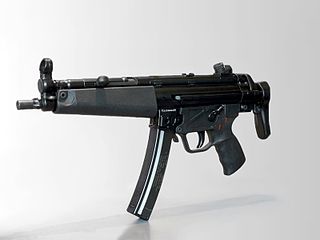
The Heckler & Koch MP5 is a submachine gun developed in the 1960s by German firearms manufacturer Heckler & Koch. It uses a similar modular design to the Heckler & Koch G3, and has over 100 variants and clones, including selective fire, semi-automatic, suppressed, compact, and even marksman variants. The MP5 is one of the most widely used submachine guns in the world, having been adopted by over forty nations and numerous militaries, police forces, intelligence agencies, security organizations, paramilitaries, and non-state actors.
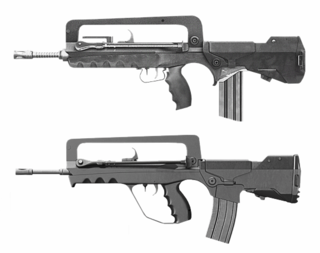
The FAMAS is a bullpup assault rifle designed and manufactured in France by MAS in 1978. It is known by French troops as Le Clairon due to its distinctive shape.

The Heckler & Koch G3 is a select-fire battle rifle chambered in 7.62×51mm NATO developed in the 1950s by the German firearms manufacturer Heckler & Koch, in collaboration with the Spanish state-owned firearms manufacturer CETME. The G3 was the service rifle of the German Bundeswehr until it was replaced by the Heckler & Koch G36 in the 1990s, and was adopted into service with numerous other countries.
The Heckler & Koch PSG1 is a semi-automatic sniper rifle designed and produced by the German company Heckler & Koch.
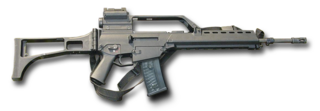
The Heckler & KochG36(Gewehr 36) is an assault rifle designed in the early 1990s by German weapons manufacturer Heckler & Koch. It is chambered in 5.56×45mm NATO, and replaced the heavier G3 battle rifle chambered in 7.62×51mm. The G36 was accepted into service with the Bundeswehr in 1997. Since then, it has been a popular export, and has seen active service in military and police units in several countries, including Germany, Spain, and the United Kingdom. The G36 is gas-operated and feeds from a 30-round detachable box magazine or 100-round C-Mag drum magazine.

The Heckler & Koch SL8 is a semi-automatic rifle manufactured by Heckler & Koch. It is a civilian version of the Heckler & Koch G36.

The Heckler & Koch HK416 is an assault rifle chambered for the 5.56×45mm NATO cartridge. It is designed and manufactured by the German company Heckler & Koch.
The Sturmgewehr 57 is a selective fire battle rifle designed by Schweizerische Industrie Gesellschaft of Switzerland. The Stgw. 57 assault rifle uses a roller-delayed blowback system similar to the blowback system of the Heckler & Koch G3 and CETME rifles. As an assault rifle, the model AM 55 entered service in the Swiss Army in three designations F. ass. 57 7.5mm and 7.5mm Stgw. 57. Technologically, the Stgw. 57 was the mechanical and design basis for the export-variations of the SG 510 family of small arms. After thirty-three years, from 1957 to 1990, the Swiss Army replaced the Stgw. 57 with the SIG SG 550, a lighter-weight assault rifle.

The Heckler & Koch HK33 is a 5.56mm assault rifle developed in the 1960s by West German armament manufacturer Heckler & Koch GmbH (H&K), primarily for export.

The PTR rifle is a family of modern, American-manufactured, semi-automatic rifles based on the Heckler & Koch G3 battle rifle. These rifles are produced by PTR Industries, Inc. of Aynor, South Carolina for the law enforcement and civilian markets in the United States. The abbreviation PTR stands for "Precision Target Rifle."

The Heckler & KochG41 is a German 5.56×45mm NATO assault rifle introduced in 1981 and produced in limited quantities by Heckler & Koch. It was designed to replace the 7.62×51mm NATO chambered Heckler & Koch G3 and the G3 based .223 Remington/5.56×45mm and later 5.56×45mm NATO chambered Heckler & Koch HK33 service rifles providing a more modern weapon compatible with then recently introduced NATO standards. It can use both the then new STANAG 4172 compliant 5.56×45mm NATO SS109, SS110, and SS111 ammunition and older .223 Remington/5.56×45mm M193 ammunition and was the last Heckler & Koch service rifle designed around the roller-delayed blowback mechanism.
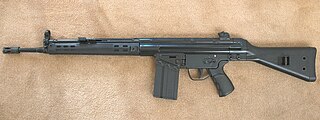
The Heckler & Koch HK41 is a semi-automatic version of the Heckler & Koch G3 battle rifle. It was produced by Heckler & Koch for civilian sales and Bundeswehr reservist market for a rifle that could be privately owned in Germany but which would duplicate the handling of the G3 for reservists to practice with. The field manual for shooting training authorised the use of HK41 by reservists in place of a G3 during special reservist range firings. But not for use in any other military activity. Usually it was called “Reservistengewehr”. The HK40-series was designed for sale to conscripts so they could be familiar with their service rifle before entering military service, a common practice in Germany and Switzerland. According to H&K's numbering nomenclature, the "4" indicates that the weapon is a paramilitary rifle, and the "1" indicates that the caliber is 7.62 mm.
The Heckler & Koch HK417 is a battle rifle designed and manufactured by Heckler & Koch.

The Heckler and Koch SR9 is a series of hunting and target rifles derived from the Heckler & Koch HK91 incorporating parts from the PSG1 and MSG-90 marksman rifles.

The CETME Model L is a Spanish 5.56×45mm NATO assault rifle developed in the late 1970s at the state-owned small arms research and development establishment CETME located in Madrid. The rifle retains many of the proven design elements the institute had used previously in its CETME Model 58 battle rifles.
The evolution of German military rifles is a history of common and diverse paths followed by the separate German states, until the mid-19th century when Prussia emerged as the dominant state within Germany and the nation was unified. This article discusses rifled shoulder arms developed in or for the military of the states that later became Germany; it excludes firearms of the Austrian Empire, except where they were used substantially by German troops.
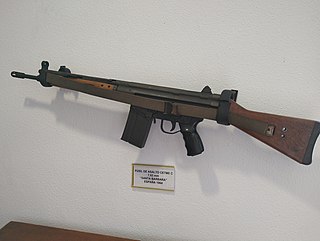
The CETME Model 58 is a stamped-steel, select-fire battle rifle produced by the Spanish armaments manufacturer Centro de Estudios Técnicos de Materiales Especiales (CETME). The Model 58 used a 20-round box magazine and was chambered for the 7.62×51mm NATO round. The CETME 58 would become the foundation of the widely deployed German Heckler & Koch G3 battle rifle. Semi-automatic variants were also produced for the civilian market.
The Zastava PAP are a series of Serbian sporting rifles based on the Zastava M70 and Zastava M77B1. They are nearly identical to their military counterparts, but lack select-fire capability and have been modified with a number of sporting features designed to comply with firearms imports laws in the United States, where they are primarily marketed.















